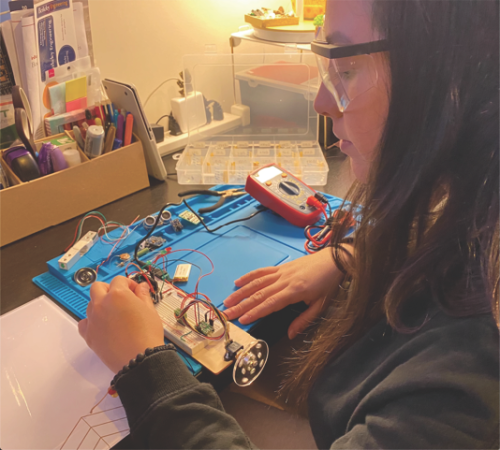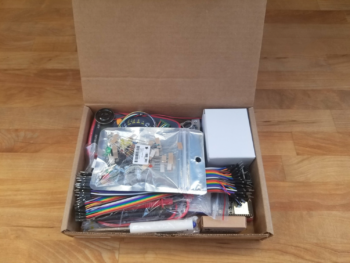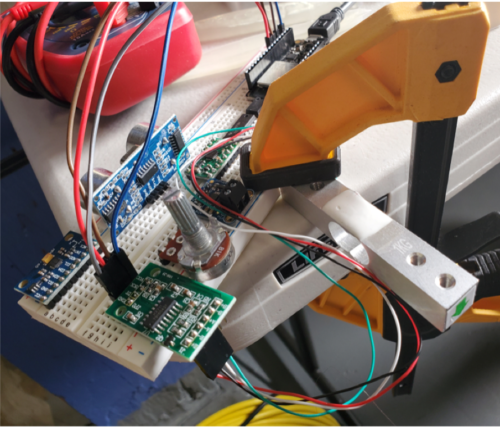MicroKits Continue ME’s Hands-On Learning Tradition
 Current and former ME students have valued both the hands-on and theoretical components that courses including Electronics for the Internet of Things (ME100), Experimentation and Measurements (ME103), and Mechatronics Design (ME102B) have offered. When instruction switched from in-person to distance learning in March because of strict state and county shelter-at-home mandates that remained in place during the Fall semester and will probably continue into the first part of the spring semester, ME faculty and staff worked together to plan, create, assemble, and distribute lab kits for distribution to students in these courses to continue the level of hands-on experience ME is known for. The team effort to organize all the components necessary to create the lab kit, or MicroKit, paid off. “This semester, the lab kits enabled each student to practice theory on real hardware at home, and this elevated engagement and retention of the materials,” said Professor Hannah Stuart, who taught ME102B, together with Professor Homayoon Kazerooni, during the fall semester. “I feel this student experience has been especially important and fulfilling when so much of our teaching must be remote.” In a parallel effort to support online instruction, more than 20 laboratory videos were created by the ME Machine Shop staff and edited by ME faculty members and graduate student instructors while comprehensive datasets were collected, which together allowed students to remotely perform data analysis that coincided with course lectures and assignments in the mechanical behavior of engineering materials, manufacturing and tolerancing, and dimensional modeling for design courses, as well as introductory and training videos for the student machine shop.
Current and former ME students have valued both the hands-on and theoretical components that courses including Electronics for the Internet of Things (ME100), Experimentation and Measurements (ME103), and Mechatronics Design (ME102B) have offered. When instruction switched from in-person to distance learning in March because of strict state and county shelter-at-home mandates that remained in place during the Fall semester and will probably continue into the first part of the spring semester, ME faculty and staff worked together to plan, create, assemble, and distribute lab kits for distribution to students in these courses to continue the level of hands-on experience ME is known for. The team effort to organize all the components necessary to create the lab kit, or MicroKit, paid off. “This semester, the lab kits enabled each student to practice theory on real hardware at home, and this elevated engagement and retention of the materials,” said Professor Hannah Stuart, who taught ME102B, together with Professor Homayoon Kazerooni, during the fall semester. “I feel this student experience has been especially important and fulfilling when so much of our teaching must be remote.” In a parallel effort to support online instruction, more than 20 laboratory videos were created by the ME Machine Shop staff and edited by ME faculty members and graduate student instructors while comprehensive datasets were collected, which together allowed students to remotely perform data analysis that coincided with course lectures and assignments in the mechanical behavior of engineering materials, manufacturing and tolerancing, and dimensional modeling for design courses, as well as introductory and training videos for the student machine shop.
MicroKit Design
To implement the design of the MicroKit, Professor Hayden Taylor, together with a department task force, integrated by faculty, staff, and students, assembled a wish list of components from ME instructors and through collaborative discussions created a kit consisting of 105 components with 59 individual part numbers. Many aspects of the kits’ usability had to be considered. For example, most students would not be able to solder at home, so kit components were modified by soldering leads or connectors to allow students to plug them directly into a project board. The kit design needed to adhere to a cohesive and synergistic laboratory instruction strategy in which essentially the same kit would be distributed to all students in ME100. ME103 and ME102B, allowing them to progressively use the knowledge and experience gained from taking one course on subsequent courses. In addition, a companion https://microkit.berkeley.edu web site was created to encapsulate all aspects of online training, collaboration, and support associated with the use the kits.
 MicroKit Assembly and Distribution
MicroKit Assembly and Distribution
Once the MicroKit component selection and support website were completed, ordering parts and assembling the required 275 kits followed. The biggest challenge was getting all components to the students on time. A short lead time compounded by unreliable vendors made meeting the deadline very challenging. Kits were assembled by staff members who worked evenings and weekends to meet delivery deadlines. Professor Stuart remarked, “The team of staff and faculty who worked hard to make this experience happen are extremely dedicated to creating meaningful new student experiences.”
Once kits were assembled, distribution commenced. Courses instructors collected students’ names and addresses to create mailing labels. Many locally-based students picked up kits in person, while some had to be hand-delivered by staff members. Out-of-area domestic and international students received their kits via FedEx. R&D Engineer II Tom Clark drove to the FedEx Emeryville Hub to complete multiple processes before shipments were sent, while Facilities Specialist Robert Jenkins worked with FedEx to get kits through customs at international locations.
MicroKit Cost
The cost of assembling and distributing the 275 kits came to approximately $60k with General Motors contributing $30k to support the project. The Department anticipates needing at least 325 kits for the spring 2021 semester at an estimated cost of $65k. To avoid any lag time and to ensure that vendors have all components available, orders will be placed within the next few weeks.
The Future
 Since distance learning will continue during the spring 2021 semester, modifications will be made to create a more universal MicroKit that students can use throughout their academic careers. And when classes return to in-person instruction, faculty members have expressed an interest in retaining the kits. Unlike past semesters when student teams shared resources, incoming students would receive a standard kit when enrolling in their first lab course that would be used in future classes. “The kit has allowed us to refine and expand many lab activities,” says Professor Taylor. “We also believe that, by giving each student their own kit, their levels of understanding and competence have become higher and more uniform. Each student works on all aspects of the laboratory assignment.” While each student would receive a kit at a projected cost of $88, some components could be shared among students. For example, students could pool motors to build vehicles.
Since distance learning will continue during the spring 2021 semester, modifications will be made to create a more universal MicroKit that students can use throughout their academic careers. And when classes return to in-person instruction, faculty members have expressed an interest in retaining the kits. Unlike past semesters when student teams shared resources, incoming students would receive a standard kit when enrolling in their first lab course that would be used in future classes. “The kit has allowed us to refine and expand many lab activities,” says Professor Taylor. “We also believe that, by giving each student their own kit, their levels of understanding and competence have become higher and more uniform. Each student works on all aspects of the laboratory assignment.” While each student would receive a kit at a projected cost of $88, some components could be shared among students. For example, students could pool motors to build vehicles.
MicroKits have also received positive feedback from students who value the hands-on experience and independent learning the kits provide. “I have been able to test my understanding on controls, linkages, and electronics while learning how to utilize the different electronic parts that I did not know how to use before,” says ME senior Natalia Perez Triana. “In addition, it has inspired me to work on my own projects . . . . I hope we keep using this kit in future semesters since I believe it is fundamental that every ME student have this kind of experience before graduating.”
Help fund MicroKits for Mechanical Engineering Students
Testimonials
[pt_view id=”dc03cd4hmq”]
